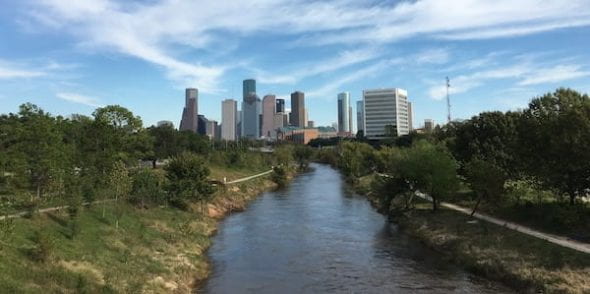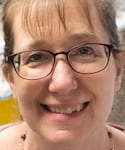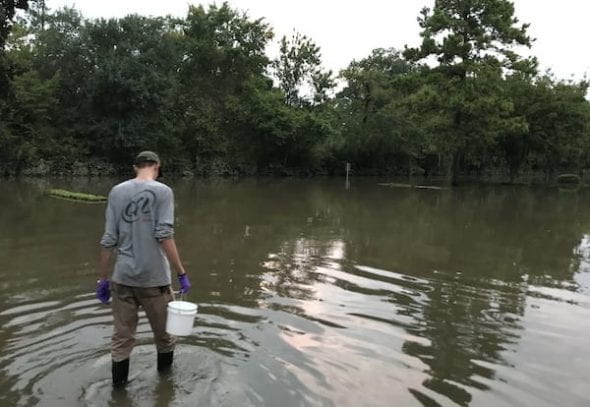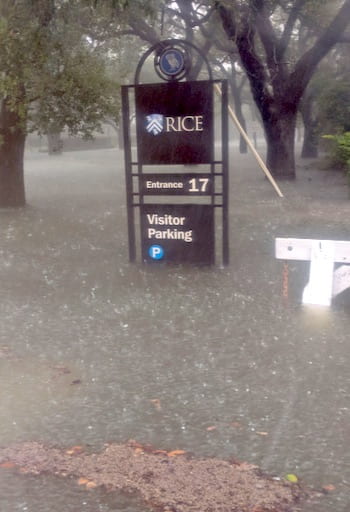THREE EEPS GRADUATES RECEIVE COVETED NSF EARTH SCIENCES POSTDOCTORAL FELLOWSHIPS
Three Earth, Environmental and Planetary Sciences 2020 Ph.D. graduates are awarded prestigious National Science Foundation (NSF) Postdoctoral Fellowships – a record for the department. Brandee Carlson, Tian Dong and Andrew Moodie, all from the same laboratory group, receive the highly competitive grant after submitting research proposals to the Division of Earth Sciences at NSF. The scope of the evaluation considers the scientific merits of the proposal, and the potential for transformative research as well as professional development by training recipients for research and leadership positions. The grants provide two years of salary and research support at an institution of the fellows choosing.
These postdoctoral fellowships are only offered to early-career scientists, so student supervisors are relied upon to discuss fellowship opportunities with their students during their graduate careers. Assistant professor Jeff Nittrouer, primary advisor for Carlson, Dong, and Moodie, strongly encouraged them to apply to the NSF program and is thrilled with the results.
“I could not be more proud of them,” says Nittrouer. “Collectively, they’ve shown how a laboratory raises the bar and thrives, demonstrating that scientific success comes from collaborations with fellow students and colleagues, both here at Rice and globally.”

EEPS 2020 Ph.D. graduates (L to R) Tian Dong, Brandee Carlson and Andrew Moodie all receive NSF Earth Sciences Postdoctoral Fellowships
“In the past six years, Brandee, Andrew, Tian, and Chen Wu [PhD, 2020] have cultivated a special culture: inclusiveness and sharing of ideas and resources, typifying the mantra that the sum of the parts is greater than the whole.” -Dr. Jeff Nittrouer
In terms of their upcoming research ventures, they’ll rely on recent experiences, in particular, working in far-flung localities and remote environments.
Brandee Carlson heads to the University of Colorado, Boulder, to collaborate with Prof. Irina Overeem in the Institute of Arctic and Alpine Research. Dr. Carlson is exploring delta front processes of Arctic rivers, focusing research in Greenland, where under warming climate conditions, river sediment supply is increasing due to rapidly retreating glaciers and thawing permafrost. Dr. Carlson plans to investigate how failures on multiple Arctic deltas vary by water and sediment discharge. Her work includes several field campaigns combined with CU’s extensive remote sensing capabilities. The project dovetails with her previous work on the Yellow River delta but will ultimately expand her expertise to include sediment transport at a variety of delta fronts and climate conditions.
Tian Dong will study how physical processes shape river morphology, working with Dr. Timothy Goudge at the University of Texas at Austin. Tian will develop new metrics to distinguish between meandering and braided river patterns, from sediment deposits, drill cores, remote sensing, and the rock record. The goals are to identify the prevalence of these river types for the past eon of earth’s history and improve groundwater reservoir models. Ultimately, the metrics may be translatable to the paleoclimate record of other terrestrial planets, including Mars.
Andrew Moodie will collaborate between Stanford University and the University of Texas, working with Drs. Jef Caers and Paola Passalacqua, respectively. Dr. Moodie’s project seeks to improve an understanding of subsurface delta sediment distribution and ground fluid movement, using machine learning algorithms. The aim is to distinguish how multiple natural and anthropogenic factors, including as sea level change and infrastructure development, influence delta systems.
According to Andrew, “Our understanding of subsurface fluid transport in river deltas is limited. Improving our ability to manage water resources and mitigate pollutant transport lowers risk to societal health. And predicting ground-fluid transport relies on models to constrain subsurface composition, however due to the complexity of river-delta environments, accurate assessments are difficult. Using machine learning to better constrain environmental heterogeneity will benefit society and the cultures that live on deltas globally”.
Although the group splits at the end of the academic term, all agree that their experiences at Rice have collectively enhanced their future as scientists and mentors.
“Lessons learned abroad were brought back here” [to Rice] says Brandee. “Countless hours of discussion, sharing ideas on white boards and helping write each other’s codes all enhanced our scientific successes.”
Nittrouer concludes, “Rice’s motto is ‘Unconventional Wisdom’. When I view the accomplishments of these students, I can’t help but applaud their unconventional generosity, humility, and determination. These students selflessly helped one another, and thanks to the support here at Rice, there was no lack for opportunity”.
JGR Planets: The solidus and melt productivity of nominally anhydrous Martian mantle constrained by new high pressure-temperature experiments – Implications for crustal production and mantle source evolution
Shuo Ding, Rajdeep Dasgupta, Kyusei Tsuno
Abstract: We constrained the solidus of a model Martian composition with low bulk Mg# (molar MgO/(MgO + FeOT) × 100 ~75) and high total alkali (Na2O + K2O = 1.09 wt.%) concentration at 2 to 5 GPa by experiments. Based on the new solidus brackets, we provide a new parameterization of the solidus temperature as a function of pressure of Martian mantle: Ts (°C) = − 5P (GPa)2 + 107P(GPa) + 1,068. The newly constrained solidus of the Lodders and Fegley (1997; https://doi.org/10.1006/icar.1996.5653) model Martian composition (LF composition) is 20 to 90 °C lower than the previous solidus of model Martian mantle with lower total alkali (~0.54 wt.%). The supersolidus experiments yield an average isobaric melt productivity, dF/dT, of 20 ± 6 wt.%/100 °C. We also bracketed the solidi of model Martian mantle compositions with low Mg# (~75) and low alkali (~0.54 wt.%), and with high Mg# (~80) and low alkali (~0.54 wt.%) at a constant pressure of 3 GPa. We find that bulk Mg# enhances the solidus temperature and bulk total alkalis suppress it. A parameterization that estimates the effect of bulk Mg# and total alkalis on peridotite solidus, including Mars and Earth, at 3 GPa can be described as: Ts(°C) = 4.23Mg # − 85(Na2O(wt. %) + K2O(wt. %)) + 1,120. Based on the new solidus parameterizations, 10–40 km more Martian crust would be produced by columnar decompression melting for LF model composition compared to the low Mg#‐low alkali model composition. The quantitative constraints on the solidus shift with Mg# and total alkalis from this study can be used to assess the Martian mantle solidus change through melting and melt extraction over time and the role of mantle heterogeneity in crustal production.
Ding, S., Dasgupta, R. & Tsuno, K. (2020). The solidus and melt productivity of nominally anhydrous Martian mantle constrained by new high pressure-temperature experiments – Implications for crustal production and mantle source evolution. Journal of Geophysical Research – Planets 123, e2019JE006078. doi:10.1029/2019JE006078
AGU Monograph: The effect of variable Na/K on CO2 solubility in slab-derived rhyolitic melts
The effect of variable Na/K on CO2 solubility in slab-derived rhyolitic melts
Michelle Muth, Megan S. Duncan, Rajdeep Dasgupta
Abstract: We conducted high pressure, high temperature experiments to investigate the effect of variable alkali ratio on the CO2‐rich fluid solubility in hydrous rhyolitic melts at sub‐arc depths. Experiments were performed at 3.0 and 1.5 GPa, 1300 °C on rhyolitic compositions similar to low‐degree partial melts of subducted slab lithologies, with fixed total alkalis (Na2O+K2O ~11.5 wt.%, volatile‐free), but Na# (molar Na2O/[Na2O+K2O]) varying from 0.15 to 0.88. In the experimental glasses, total dissolved CO2 (CO2tot.) ranged from 2.14 ± 0.07 to 3.20 ± 0.07 wt.% at 3.0 GPa, and from 0.70 ± 0.02 to 1.19 ± 0.02 wt.% at 1.5 GPa. Experiments showed a general positive correlation between Na# and CO2tot., with the exception of the highest Na# experiment at 1.5 GPa. Carbon was dissolved as molecular CO2 (CO2mol.) and carbonate (CO32‐). As Na# increased, CO2mol./CO2tot. decreased from 0.94 to ~0.00 in the 1.5 GPa experiments and from 0.65 to 0.05 in the 3.0 GPa experiments. Variability in CO2 concentration is larger and more clearly correlated with Na# at 3.0 GPa, indicating that this effect is pressure dependent. Our results show that compositional variability in silicic melts must be considered to accurately place constraints on the limit of CO2 transfer in subduction zones.
Muth, M., Duncan, M. S., Dasgupta, R. (2020). The effect of variable Na/K on CO2 solubility in slab-derived rhyolitic melts. In Manning, C., Lin, A., and Mao, W. (Eds.) Carbon in Earth’s Interior, Geophysical Monograph 249, 195-208. doi:10.1002/9781119508229.ch17
GRL: Size of the atmospheric blocking events: Scaling law and response to climate change
, , , & ( 2019). Size of the atmospheric blocking events: Scaling law and response to climate change. Geophysical Research Letters, 46. https://doi.org/10.1029/2019GL084863
Abstract
Understanding the response of atmospheric blocking events to climate change has been of great interest in recent years. However, potential changes in the blocking area (size), which can affect the spatiotemporal characteristics of the resulting extreme events, have not received much attention. Using two large‐ensemble, fully coupled general circulation model (GCM) simulations, we show that the size of blocking events increases with climate change, particularly in the Northern Hemisphere (by as much as 17%). Using a two‐layer quasi‐geostrophic model and a dimensional analysis technique, we derive a scaling law for the size of blocking events, which shows that area mostly scales with width of the jet times the Kuo scale (i.e., the length of stationary Rossby waves). The scaling law is validated in a range of idealized GCM simulations. Predictions of this scaling law agree well with changes in blocking events’ size under climate change in fully coupled GCMs in winters but not in summers.
Rice’s Laurence Yeung named 2017 Packard Fellow
– OCTOBER 16, 2017
Rice’s Laurence Yeung named 2017 Packard Fellow
Geochemist wins prestigious grant for innovative research into ‘clumped’ isotopes
HOUSTON — (Oct. 16, 2017) — Rice University’s Laurence Yeung has made a career of searching for some of Earth’s rarest molecules and the stories they tell about the planet’s past, present and future. To aid his search, the David and Lucile Packard Foundation has awarded Yeung a 2017 Packard Fellowship for Science and Engineering.
Packard Fellowships, which include a largely unrestricted five-year research grant of $875,000, are among the most prestigious early career awards for U.S. scientists and engineers. Only 18 are awarded each year.
“My first response was excitement: ‘Oh my God. I cannot believe this is happening,’ and then I looked at everyone who’d come before and won one of these, and I thought, ‘Really? How can I be one of these people?’” said Yeung, assistant professor of Earth, environmental and planetary sciences. “The way I think about it is, ‘Congratulations. Now, earn it.’”
Yeung joined Rice in 2015. His research is a mix of physical chemistry, photochemical experimentation, quantum-mechanical theory, atmospheric modeling and more, all aimed at understanding how the atmosphere broadcasts the state of the Earth system in its chemical composition.
“People sometimes call the atmosphere the ‘great communicator’ because it’s the first to respond to any perturbation in Earth systems,” Yeung said. “Altering anything from volcanic emissions to biological productivity can result in changes in the atmosphere’s makeup and its chemistry.”
He said there are many processes scientists still don’t understand about the atmosphere’s basic workings. For example, they cannot confidently predict how much the atmosphere will warm or cool if it has different amounts of greenhouse gases. They also don’t know how the composition of the atmosphere changes as the biosphere responds to global change.
“Understanding these processes and others could help us better understand climate dynamics, the evolution of Earth’s surface and even how to search for life on other planets,” Yeung said.
His core approach typically revolves around counting exact numbers of extraordinarily rare molecules that contain two or more rare isotopes, atoms of the same element that differ only in their mass. Fundamental processes — like photosynthesis in plants or ozone chemistry in the atmosphere — change the odds that “clumped” isotopes will be created. For each process, the odds change in a characteristic way, which means clumped isotopes can serve as calling cards for specific processes.
However, sifting through millions of molecules to find a handful of these ultrarare clumped isotopes is not uncommon. “The measurements we do are incredibly hard,” Yeung said. “It takes big, heavy instruments to measure a small number of samples extremely carefully.”
He said the Packard Fellowship will allow him to take research risks he couldn’t otherwise afford. Some of these risks involve finding new archives for ancient atmospheric properties, while others entail discovering new ways to detect the imprints of life in a variety of environments.
“Basically, every one of these ideas is risky,” he said. “In some cases, you’re not sure about the math or the model that you’ve put together. There could also be questions about your samples. And even if you get all of that right, your instruments might not be good enough to resolve the detail that’s necessary.”
One project he’s considering is attempting to create a compact device that makes isotopic measurements far more accessible.
“It’s unlikely that this device will be able to make measurements with the same precision that we do in the lab today, but if the precision were good enough, and we could go places — a boat, a mountaintop, a drone — and collect tenfold or hundredfold more data, it would be transformative.
“At the end of five years, I’d like to see that some of the risks paid off and some didn’t,” he said. “If they all pay off, then you’re not taking enough chances and pushing to stay right there at the edge of what’s possible.”
Other Rice faculty who have been named Packard Fellows include Cin-Ty Lee and Rajdeep Dasgupta, also of the Department of Earth, Environmental and Planetary Sciences, and Doug Natelson and Tom Killian, both of the Department of Physics and Astronomy.
Since the Packard Fellows program was begun in 1988, the Packard Foundation has awarded $394 million to support 577 scientists and engineers from 54 top universities. Packard Fellows have gone on to receive awards and honors that include the Nobel Prize in Physics, the Fields Medal, the Alan T. Waterman Award, MacArthur Fellowships and election to the National Academies.
A high-resolution IMAGE is available for download at:
http://news.rice.edu/files/2017/10/1016_PACKARD-yeung136-lg-1i08jz2.jpg
CAPTION: Laurence Yeung (Photo by Jeff Fitlow/Rice University)
Related stories from Rice:
Earth scientist Laurence Yeung wins Clarke Award — Feb. 29, 2016
http://news.rice.edu/2016/02/29/earth-scientist-laurence-yeung-wins-clarke-award/
Oxygen atmosphere recipe = tectonics + continents + life — May 16, 2016
http://news.rice.edu/2016/05/16/oxygen-atmosphere-recipe-tectonics-continents-life/
Study: Photosynthesis has unique isotopic signature — April 23, 2015
http://news.rice.edu/2015/04/23/study-photosynthesis-has-unique-isotopic-signature/














